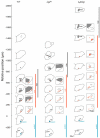Brainstem respiratory oscillators develop independently of neuronal migration defects in the Wnt/PCP mouse mutant looptail
- PMID: 22363567
- PMCID: PMC3281908
- DOI: 10.1371/journal.pone.0031140
Brainstem respiratory oscillators develop independently of neuronal migration defects in the Wnt/PCP mouse mutant looptail
Abstract
The proper development and maturation of neuronal circuits require precise migration of component neurons from their birthplace (germinal zone) to their final positions. Little is known about the effects of aberrant neuronal position on the functioning of organized neuronal groups, especially in mammals. Here, we investigated the formation and properties of brainstem respiratory neurons in looptail (Lp) mutant mice in which facial motor neurons closely apposed to some respiratory neurons fail to migrate due to loss of function of the Wnt/Planar Cell Polarity (PCP) protein Vangl2. Using calcium imaging and immunostaining on embryonic hindbrain preparations, we found that respiratory neurons constituting the embryonic parafacial oscillator (e-pF) settled at the ventral surface of the medulla in Vangl2(Lp/+) and Vangl2(Lp/Lp) embryos despite the failure of tangential migration of its normally adjacent facial motor nucleus. Anatomically, the e-pF neurons were displaced medially in Lp/+ embryos and rostro-medially Lp/Lp embryos. Pharmacological treatments showed that the e-pF oscillator exhibited characteristic network properties in both Lp/+ and Lp/Lp embryos. Furthermore, using hindbrain slices, we found that the other respiratory oscillator, the preBötzinger complex, was also anatomically and functionally established in Lp mutants. Importantly, the displaced e-pF oscillator established functional connections with the preBötC oscillator in Lp/+ mutants. Our data highlight the robustness of the developmental processes that assemble the neuronal networks mediating an essential physiological function.
Conflict of interest statement
Figures









Similar articles
-
The mouse Wnt/PCP protein Vangl2 is necessary for migration of facial branchiomotor neurons, and functions independently of Dishevelled.Dev Biol. 2012 Sep 15;369(2):211-22. doi: 10.1016/j.ydbio.2012.06.021. Epub 2012 Jul 4. Dev Biol. 2012. PMID: 22771245 Free PMC article.
-
The embryonic development of hindbrain respiratory networks is unaffected by mutation of the planar polarity protein Scribble.Neuroscience. 2017 Aug 15;357:160-171. doi: 10.1016/j.neuroscience.2017.05.046. Epub 2017 Jun 3. Neuroscience. 2017. PMID: 28583412
-
Wnt activity guides facial branchiomotor neuron migration, and involves the PCP pathway and JNK and ROCK kinases.Neural Dev. 2009 Feb 11;4:7. doi: 10.1186/1749-8104-4-7. Neural Dev. 2009. PMID: 19210786 Free PMC article.
-
Developmental basis of the rostro-caudal organization of the brainstem respiratory rhythm generator.Philos Trans R Soc Lond B Biol Sci. 2009 Sep 12;364(1529):2469-76. doi: 10.1098/rstb.2009.0090. Philos Trans R Soc Lond B Biol Sci. 2009. PMID: 19651648 Free PMC article. Review.
-
Vangl1 and Vangl2: planar cell polarity components with a developing role in cancer.Endocr Relat Cancer. 2014 Oct;21(5):R345-56. doi: 10.1530/ERC-14-0141. Epub 2014 Jun 30. Endocr Relat Cancer. 2014. PMID: 24981109 Free PMC article. Review.
Cited by
-
Celsr1 suppresses Wnt5a-mediated chemoattraction to prevent incorrect rostral migration of facial branchiomotor neurons.Development. 2022 Nov 15;149(22):dev200553. doi: 10.1242/dev.200553. Epub 2022 Nov 16. Development. 2022. PMID: 36325991 Free PMC article.
-
The mouse Wnt/PCP protein Vangl2 is necessary for migration of facial branchiomotor neurons, and functions independently of Dishevelled.Dev Biol. 2012 Sep 15;369(2):211-22. doi: 10.1016/j.ydbio.2012.06.021. Epub 2012 Jul 4. Dev Biol. 2012. PMID: 22771245 Free PMC article.
-
Key Features of Structural and Functional Organization of Zebrafish Facial Motor Neurons Are Resilient to Disruption of Neuronal Migration.Curr Biol. 2017 Jun 19;27(12):1746-1756.e5. doi: 10.1016/j.cub.2017.05.033. Epub 2017 Jun 9. Curr Biol. 2017. PMID: 28602649 Free PMC article.
-
Defective Neuronal Positioning Correlates With Aberrant Motor Circuit Function in Zebrafish.Front Neural Circuits. 2021 Jun 24;15:690475. doi: 10.3389/fncir.2021.690475. eCollection 2021. Front Neural Circuits. 2021. PMID: 34248505 Free PMC article.
-
The rostral medulla of bullfrog tadpoles contains critical lung rhythmogenic and chemosensitive regions across metamorphosis.Comp Biochem Physiol A Mol Integr Physiol. 2018 Nov;225:7-15. doi: 10.1016/j.cbpa.2018.05.024. Epub 2018 Jun 8. Comp Biochem Physiol A Mol Integr Physiol. 2018. PMID: 29890210 Free PMC article.
References
-
- Guerrini R, Parrini E. Neuronal migration disorders. Neurobiol Dis. 2010;38:154–166. - PubMed
-
- Verrotti A, Spalice A, Ursitti F, Papetti L, Mariani R, et al. New trends in neuronal migration disorders. Eur J Paediatr Neurol. 2010;14:1–12. - PubMed
-
- Aicardi J. The place of neuronal migration abnormalities in child neurology. Can J Neurol Sci. 1994;21:185–193. - PubMed
Publication types
MeSH terms
Substances
Grants and funding
LinkOut - more resources
Full Text Sources
Molecular Biology Databases

